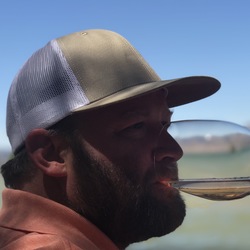Ten Thousand Vines
Monte Dall'Ora
Camporenzo Valpolicella Classico Superiore Corvina Blend 2013
From a vineyard a few miles from their main property. Vines are less than ten years old. Not as acidic or minerally as regular bottling of their valpo. The aging gives this a richness that the valpo Classico doesn't have. Not better, just different — 8 years ago
Château Saint-Roch
Chimères Cotes du Roussillon Villages Grenache Blend 2013
100+ year old vines from the foot of Château de Quéribus, the last Cathar stronghold, and probably the most epic looking castle ever (seriously, look at it, google images...). Jeb Dunnuck scored less than ten 2013 Chateauneuf du Papes higher than this, and for good reason. This is what I imagine strawberry shortcake would taste like if you were some how able to commission Pierre Hermé to pull one together on-the-fly for you. Hedonistic and raw, but with rounded edges. Just as you think you've wrapped your head around it, it turns a corner and unveils something new. True to Roussillon, hedonistic, honest, better than any Cotes du Rhone I've ever tasted, and at less than $20, it's simply one of greatest values possible in all wine. — 9 years ago



Zanotto
Col Fondo Glera
good carbonated wine. gets me drunk REAL fast like one sip and I'm fucking DRUBK
But I don't drive while I'm drunk, and neither should you. In 2015 alone, over ten thousand people died in a drunk driving related accident. Please, if you are thinking about driving drunk, just remember that in California drunk driving is punishable by $1,000 fine and/or six months imprisonment (not to mention thousands of dollars in legal fees). Just remember: Stay Alive, Don't Drink And Drive.
but yea, good wine tho — 9 years ago
Château d'Oupia
Les Hérétiques Pays d'Hérault Carignane Syrah 2014
Carignan from 40 year old vines. A 50/50 mix of barrel fermentation & carbonic. This is a brilliant means of handling Carignan. It has the powerful, brooding dark fruit, but also shows a youthful approachability as the structure is tamed somewhat. I frankly find it astonishing that this can be on shelves for ten bucks. It is a bit one note, but that note is a really good one. — 9 years ago
Ten Thousand Vines
Cabo Rojo Red Blend
Great all around blended red from a local micro-winery. — 10 years ago
Domaine des Terres Dorées (Jean-Paul Brun)
Moulin-à-Vent Gamay
Tasted the 2012 vintage in 2013. This wine is well balanced and medium tannins, fruit and acidity. Granite soils and metamorphic rock, in which the vines roots need to search to find their nourishment and stressed in their development. This wine pairs exceptionally well with game and aged cheeses. Structured well with Minerality, red fruit, and tannins integrated and promising another ten years of aging potential if you could wait this long to enjoy. — 10 years ago
Bodegas Breca
Old Vines Garnacha de Fuego 2011
Good for a Tuesday night. On sale for 7.99. Normally ten. — 13 years ago
Sinegal Estate
Reserve Cabernet Sauvignon Blend 2016
Of the Napa wines I tasted over 4 days on this trip, the 16 Sinegal Reserve & the 13 Seavey Cabernet were my favorites. Both great wines but, stylistically very different. The Seavy big and bold and the Sinegal pure beauty & elegance.
The nose reveals very dark currants. Dark & milk chocolate. Blackberries, creamy black raspberries, black plum & plum, mocha powder, core of anise, beautiful dark spice, soft volcanic soils, some dry brush and lavender, violets and fresh dark red florals.
The body is full. The tannins are really meaty but, exceptionally soft, fine and meaty. Lots of dark spice with plenty of heat. The mouthfeel is gorgeously sexy with feminine elegance. Dark & milk chocolate. Blackberries, creamy black raspberries, black plum & plum, mocha powder, core of anise, beautiful dark spice, big sweet tarry notes, soft volcanic soils, some dry brush, lavender, violets and fresh dark red florals. The acidity is perfect. The finish is well balanced sexy and gorgeous. The structure, tension say this needs to cellar eight to ten years.
Photos of; tasting cellar area, modern stainless tanks, outside terrace tasting and or dining area and their grounds and lake.
Producer history and notes...Sinegal Estate was founded in 2013 with wines made from their 30 acre Inglewood estate in St Helena (not to be confused with the Inglenook Estate in Rutherford). This is not a new property, it was part of an original land grant and its more modern day history dates back to 1879 when owner Alton Williams purchased the property and planted the first vines in 1881.
The property has changed owners a number of times over the decades. At one point the Jaegers’ owned the estate, Bill Jaeger and his wife Lila lived here. These Napa Valley pioneers were in part responsible for helping establish Freemark Abbey and Rutherford Hill. Lila was also a gardener and established beautiful gardens on the property.
Owners, David (father)and James (son) Sinegal purchased the property in 2013. James was the co-founder of Costco and once CEO. David worked at Costco for 21 years.
After the purchase, David divided each of their vineyards into smaller blocks, picking selectively (30 times in 2013) rather than all at once, and adding technology to the vineyards so they have up to the date reports on a number of data points including temperatures, soil moisture and various barometric pressures. If they want to selectively water, say vine #67 in row number three, they can do so with their irrigation system. Extremely efficient!
Nine acres of vines are planted to various red varietals including; Cabernet Sauvignon, Cabernet Franc, Malbec and Petit Verdot. They have some of the older Cabernet Franc vines in the valley that are 30+ years old.
The soils here are diverse and can vary even within small geographic ranges on the property. Some of their vineyards are planted on the valley floor – while their upper vineyards are hillside, on the edges of the Mayacamas Mountains.
Their landscape above the property is interesting and part of the Mayacamas Mountains. Visually, it appears drier than other parts of this mountain range and the vegetation reflects that with grey pine and more open natural vegetation rather than the thicker wooded vegetation more commonly associated with parts of Spring and Diamond Mountains to the north.
After purchasing the property, David created planned and laid out his vision to create a world-class boutique wine making operation. Many wineries in the Napa Valley can take years before they come to fruition, not so here. After only about 10 months, the existing winery was remodeled. 6,500 feet of caves were expanded and drilled into the hillside behind the winery and a new hospitality center was built. The hospitality center ties in very well with the winery. From the small tasting room, large doors open revealing the tanks.
A vegetable garden slightly under an acre grows just south of the winery building. Vegetables from this garden are sold to nearby restaurants.
A skeleton key appears on the labels of their wine and is prominently displayed on the outside of their winery building. This has historical significance. The original key opens the front door to the historic home on site and is displayed in the tasting room. With respect to the history of this property, this one key has already become iconic to the brand.
You only need to look inside of the winery to see that their wine making team is focused on quality. Each of the small lot tanks have built in pumps which can be controlled and programmed to do pump-overs anytime of the day or night. In addition, these tanks have multiple points at which the temperature can be controlled. These tanks do not necessarily handle all their fermentation’s. They also ferment small lots in puncheons and barrels as needed. Control across the board is the key here and it is the control of the details in wine making that is is so integral from when the fruit first arrives through to when it is bottled.
2013 was their inaugural release. The focus is currently on two primary varietals, Sauvignon Blanc and Cabernet Sauvignon. The 2013 Sauvignon Blanc were sourced from the estate but, then it was determined it was growing in an area better suited for red varietals so it was torn up and new plantings were made in the back of the property. While not far from these original plantings, their new home for their Sauvignon Blanc features different soils and is growing in a cooler part of the property.
The wine making team has been experimenting with the style of this varietal since 2013 with subsequent vintages seeing more oak. Especially, using the slightly longer cigar shaped barrels , which have extra surface area for maximizing complexities including textural feel imparted from aging the wine on the lees in these particular barrels. Maceration on the red wines is often 8-10 days and sometimes up to 20 days.
Most of their sales are direct to visitors or through their mailing list. However, they do have some distribution outside California in Florida, New York and Washington. Primarily to restaurants. — 7 years ago


Beaulieu Vineyard
Maestro Collection Ranch No. 11 Rutherford Zinfandel 2013
Zinfandel from BV Tanch No 11 in St. Helena - Northern Napa Valley- sandy vineyard - vines planted 1968 - boysenberry, black cherry, currant, spiced with crushed pepper, espresso, black licorice. Ripe Juicy Berries with long finish. Aged ten months in oak adds caramel nuances. — 9 years ago
Moone
One Thousand Vines Napa Valley Cabernet Sauvignon 2014
Prat Sura
La Cuvée Vacqueyras Grenache Syrah Blend 2012
The 2012 Olivier Gras Prat Sura Vacqueyras La Cuvée is certainly more giving on the second day—this structured Vacqueyras wants to unfurl slowly, no surprise, because the vines are around 35 years old, and are grown in an arid climate, and in stony limestone-galet soil. Prat Sura is a single vineyard bottling, and a small one at that, at roughly 1,000 cases total. Tight on opening, but when revisited the second day, it reveals dense, bordering-on-brooding layers of blackberries steeped in fresh thyme, black raspberries and violets. Texturally, there's a lot going on, I feel that it will evolve with a bit of patience. Plum skins and fleshy black fruit at the core, trussed in firm tannins, accentuated by cinnamon bark, creosote and and the merest hint of juniper berries on the finish. Tuck this one into your cellar for five to ten years. 14.5% ABV | Sample — 10 years ago
Domaine Badoz
Côtes du Jura Trousseau 2012
Ten Thousand Vines
Old Hamburg Premium Village Malbec
Great place to visit! Wonderful tasting wines — 11 years ago
Woodward Canyon
Old Vines Washington Estate Cabernet Sauvignon 2002
One of the nicest wine we’d had in ten years. — 8 years ago
Tait Wines
The Ball Buster Barossa Valley Old Vines Shiraz Blend 2014
Some darn tasty prune juice you got here. I thought it could use some opening but it is very good. Great with a prime rib, the little bit of cab and Merlot really strengthens the Shiraz. Lovely and powerful. 9 our of ten will definitely drink again. — 8 years ago
Château Canon
Saint-Émilion Red Bordeaux Blend 1986
We were suppose to be in Napa this weekend. Sadly, no one should be in Napa/Sonoma except Firefighters and first responders. However in lieu of; the Sodhani party, appointments at Beau Vinge, Mark Herold & a steak at Cole’s Chop House, what the next best thing? #STEAKANDCLARETNIGHT at home in the backyard. This 86 was amazing with my ribeye. The kind of pleasure that causes great pause and rolls the eyes a bit. On the nose; menthol, eucalyptus, dry herbs, soft ripe blackberries, dark cherries, strawberries, baked plum, perfectly stated baking spices, stones, soft unstated spice, clay, rich dark earth, touch of black cherry cola and fresh & dark florals. The palate is heaven as it coats. The body medium full, layered and the tannins are nicely resolved but not completely...still a fair amount of life in this bottle. I’d say it’s still around it’s peak. The fruits are ripe and still fresh. Blackberries, baked plum, dark cherries, strawberries, dry cranberries, hues of blueberries, black cherry cola, sweet darker spice, vanilla, clove, nutmeg, cinnamon, dark rich earth, dry stones, tobacco, suede leather, dry clay, menthol, eucalyptus, touch of dry herbs, fresh & dry dark flowers, beautiful, round acidity, perfect 12.5% alcohol and a long, even, elegantly balanced with beautiful structure, tension & length that’s lasts two minutes. It’s in a really excellent spot. 9.6 with the ribeye and 9.4 on it’s own. Photos of; an aerial shot of Chateau Canon, owners Alain and Gerard Wertheimer who made their first big money on Chanel, own Rauzan-Segla and are worth just under a paltry 10 billion, their barrel room and their Saint-Emilion vineyard. Producer notes and history...Chateau Canon is a premier cru with a history of fine vintages. This Saint-Emilion property has long been recognised as one of the best in the appellation. It is believed that Canon was named after Jacques Kanon, the naval officer who bought estate in 1760. He built the château here and surrounded it with plantings solely of vines...a rare agricultural practice at the time. However, he then sold the estate to a Bordeaux négociant just ten years later. In 1919 it was purchased by the Fournier family, who owned the property until 1996. When they sold it to the Wertheimer family, owners of Chanel and of Rauzan-Ségla in Margaux it unfortunately had some serious problems. The cellars were contaminated with TCA, the chemical compound which causes cork taint. Many of the vines were infected by viruses and in need of being replaced. As well, part of the vineyard above the quarried cellars had subsided. Fortunately the Wertheimers had the money to fix these issues and a manager, John Kolasa with the skills. The first decade of the 21st century saw Canon begin to regain its reputation once John Kolasa retired and Nicolas Audebert at Rauzan-Ségla took over. The substantial estate covers 22 hectares on Saint-Emilion’s famous limestone plateau close to the town. The vines have an average age of 25 years and are generally planted with a southerly or south-westerly exposure. 75% of the vines are Merlot and 25% Cabernet Franc. After the grapes are hand-picked, they are fermented in traditional cone-shaped vats, before spending 18 months ageing in oak barrels, 50% new and 50% used. — 8 years ago


Forlorn Hope
Amerikanischen Kobold Kick-On Ranch Los Alamos Riesling
From the Kick On Ranch vineyard in Los Alamos in Santa Barbara County (a proposed AVA between Santa Maria Valley and Santa Ynez Valley). Apparently this vineyard is located ten miles east of the Pacific Ocean and constant winds have created a unique series of sand dunes in which these Riesling vines are planted. Brilliant pale yellow. Intensely mineral Riesling nose, with a hint of flowers, much like a Saar Riesling. Delicate and crunchy with impressive purity of fruit and high mouth-watering acidity. Long finish. Low alcohol 10,21%. In a blind tasting would have taken this for German. Impressive. — 9 years ago
Ridge Vineyards
Benito Dusi Ranch Paso Robles Zinfandel 2014
Gravelly rocky vyard with old scrub waist-high vines. Benito Dusi Ranch farmed by Benito since 1940s (older brother Dante owned vyard twice as big and half as old.... Turley/four vines/J.Dusi origins). Oldest vines in Paso. First winery to put "PasoRobles" on a wine label est 1969 (not officially AVA until ten years later in the 80s) so keep it as appellation for historical purposes even though it's a single vineyard. 3 miles south of 101. 25acres/92-years old planted in 1922. Head trained, 2.6t/a. Purple floral nose; Dark, brooding, black fruit, molasses, tar, and barrel spice on the palate. Robust well knit tannin. — 10 years ago
Two Vines
Columbia Valley Merlot Cabernet Sauvignon 2012
For under ten bucks this is a great wine. — 10 years ago
Gitton Père et Fils
Sancerre Silex Galinot Sauvignon Blanc 2007
A rich great wine with spicy notes, Wine produced from one plot"Galinot" "flint on ground, a 50 years-old vines vinified ten months in half barrels of new oak, small production and great experience — 11 years ago
Ten Thousand Vines
White Table Wine
Great micro winery! This is a refreshing coconut lime flavor — 11 years ago




















Amber Archer
$32 @bdwinecenter •
•
•
•
From what I understand after translation, this blend’s contents were produced between Riomaggiore and Volastra (of and around Cinque Terre). In my travels through Italy this past summer, I actually had the chance to visit Riomaggiore. In this seaside town of Cinque Terre, I learned that the wines produced there are very hardy. Not only are the majority of these Cinque Terre vineyards constructed into the side of the cliffs/mountains/hills (whatever you’d like to label them, they’re featured on the bottle), they are also mere meters from the sea in some cases. I remember one of the local ladies of one of the five seaside towns telling me of one vineyard (can’t remember which one, probablyyy had too much wine that day) that was only 60 meters away from the surf. With this info in mind, you know that salt water will be absorbed through the grape vines, influencing the grapes’ taste. This results in a very light, delicate brine. It almost reminds me of a sea urchin, and on a lighter note, Haruno’s seaweed salad. 😂 I really dig this wine. A very translucent gold, almost a straw. Definitely let this one warm up a tad, from drinking it completely chilled to room temp, it’s an amazing change. Definitely prefer it after some warmth has reached it. And can we talk about how amazing it is that this wine had the chance to come to the US from like 5,000 miles away where the populations probably don’t exceed a couple of thousand people—and a select few of those choosing to devote their entire lives to cultivating these grape vines? Cheers to finally getting off work 🍻#cinqueterre #manarola #riomaggiore #wine #winetasting #photooftheday #instagood #italy #blend #white #travel #love #bisson #rosenthalwines — 7 years ago